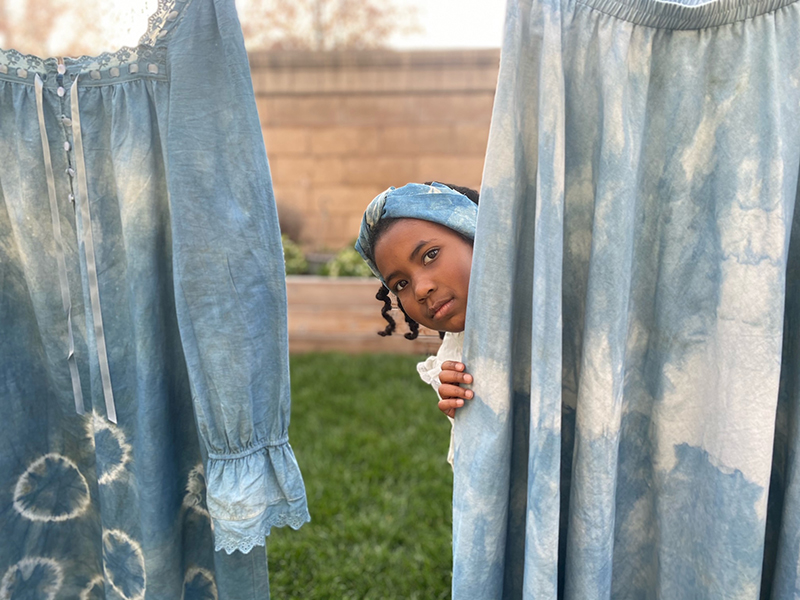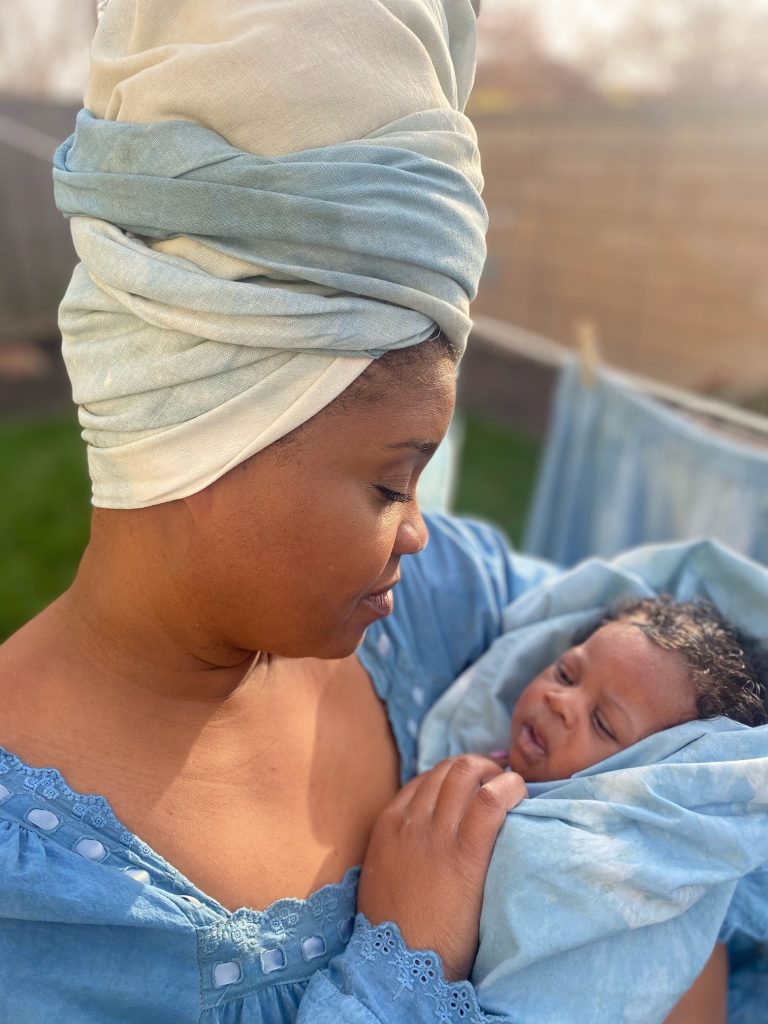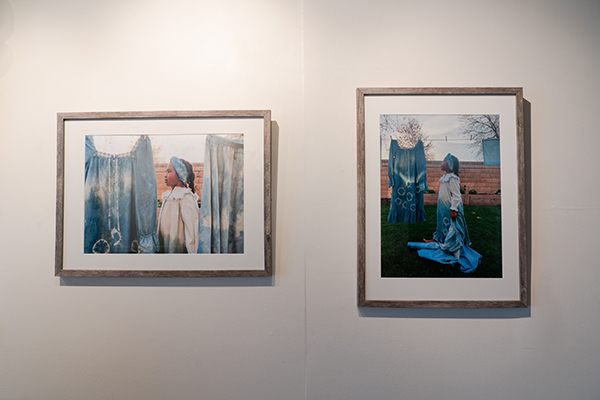
The Frank-Ratchye Project Space presents The Water Carries Us, a new body of work by De’Ana Brownfield. The Water Carries Us explores the perspectives of Black & Afro-Native women as they have been impacted by colonialism, forced removal from ancestral lands, and enslavement. Engaging with material like cotton, indigo, clay, & black walnuts, Brownfield honors her African & Afro-Native ancestors who survived the Maafa (Middle Passage) and Trail of Tears. Using traditional textiles, she explores how materials can transcend time, space, and reject colonial constructs.
In this work she seeks to acknowledge the ways that reclamation of culture acts as a practical rhythm which provides somatic healing for those impacted by enslavement and colonialism. Read on for a conversation between Brownfield and Renée Rhodes, Root Division’s Art Programs Manager.

Renée: I’ll start by asking you a little about the title – The Water Carries Us. I think it’s such an evocative title, and I was just curious to hear you talk a little more about what that title is in reference to and what that means for you in relation to this new body of work you’ve made.
De’Ana: So I thought about it when I was working with another artist, and both of us came from the diaspora where they have Guatemalan roots and Puerto Rican roots, so I thought about it and I was like: “oh wow, water is something very important for us, because our ancestors travel the waters to get to where we are now, and in my case, my ancestors were forcibly taken from their homeland and put here in the US.” And so the relationship with water is very complex in a way where, you know, the Transatlantic Slave Trade happened, carrying a bunch of African people to this new strange place that we weren’t familiar with. There is a traumatic response when it comes to water, but also there is a healing component as well where a lot of our ceremonies and rituals are connected to the water as well as our mythology. So I thought about it in a way, just honoring the water and also honoring the histories and the traumatic experiences that African people have had with water as well.
Renée: That kind of duality really reads in the project, in each of the project components that you’ve made too. I feel like there’s, you know, at first the image of the washline which can be read as this everyday ritual of cleansing and cleaning and bathing.

But there’s also, for me, an implied sense of movement in the washline. Even though it’s still in the gallery, I imagine a lot of movement and fluidity in the clothing that’s hung from it and that builds a sort of oceanic reference in a way.
De’Ana: Yeah, that’s something I really wanted to happen because, for me, working in galleries is very different. And also recognizing how galleries have a very interesting place and also can be something that can be very challenging for a lot of people—especially black folks. And so for me, I really wanted to figure out ways to be able to insinuate that this work takes place outside. I like how my pieces connect with the water, the land, and all these different natural elements, and so I really was trying to figure out how I can be able to captivate that when being in a gallery space and still be able to have the work be grounded in a way where people can still be able to create a story when they see it or be able to be in the intimate space, if that makes sense.

Renée: There’s one way that you’ve brought the outside in and brought these longer lines of stories in. I think it maybe comes in the usage of natural dyes, and I was just wondering if you could talk a little bit about how you’ve treated the textiles in the show with natural dyes—like indigo, and black walnut— and just what those dyes, what those plants, what their histories are for you, and how that kind of ties into the larger storytelling that you’re after in this project?
De’Ana: So indigo comes up because I have Nigerian ancestry, so that’s one of the things that I was able to learn about through the Dawes Rolls. The Dawes Rolls was a document that included the Afronative—but people also call them freedmen—who were enslaved by specific tribes. My family comes from the Chocktaw and Chickasaw tribal nations. On my mom’s grandmother’s side, one of the ancestors was from Nigeria and wrote that he came from Nigeria, and so that was one part that we were able to trace back from that documentation. So for me, it was always interesting to not know that before finding the papers. That I’ve always been connected to the Nigerian people and people always came up to me and were like “oh, are you Nigerian? You look like it” and so finding that out was a beautiful moment for me.
Before that I was always drawn to indigo and how it was a very important color for Nigerian people as well as something that was also used during the enslavement of my ancestors. They were craftsmen and had a lot of skills and knowledge of indigo, and people were strategic in sourcing specific types of people when it comes to labor.

For the walnut, black walnut is very important because it was something really big in the diets of native people as well as the freedmen. And so, I thought it was really cool to connect food, and how food also holds memory and is something that sustains communities as well and that is something I want to explore more, and how food plays a big part in preserving cultures and identities.
For me, my process is very intuitive and I don’t necessarily do intensive research when it comes to working with these materials—I just try it out and see what kind of result I get. For the patterns on the materials, I’ll use cowrie shells and black walnuts. I’ll have that on the dress and kind of wrap it around, so they create these circles.
I just use a lot of techniques that are connected to Nigerian textile practices and that’s something that I thought was really cool to combine, both Indigenous materials that are very important, but also still have them be connected to African practices. And I thought it would be very important to use the two in that kind of way because I feel like there is this idea that those identities are separate. Oftentimes, Afro-Indigenous people, Black Natives don’t get recognized. Because I’m moving in this world as a Black woman and I read as a Black woman, I’m not able to claim my Indigeneity from both my African ancestry, but also my Native American ancestry. And so I thought it was important to be able to have that conversation with, you know, what does it mean to be that and how it is important to recognize and reclaim myself as Afro-Indigenous, especially during these times, and acknowledging the history of Black Native people being a race in U.S. history as well as not being recognized by specific tribes because of having Black or African ancestry. I thought about the materials in that kind of way too.
It was very interesting for me to work with it because it has a historical context where it goes beyond, far back before enslavement, when there was already a legacy where Nigerian people were using indigo, but also when it comes to the point of slavery, that was something a lot of African people cultivated and helped form the economy of the U.S. I thought that was very interesting and I wanted to work with that material in my work, because of my ancestry, but also the knowledge around how specific industries, like cotton and indigo, were something very big in West African countries and how there is a history of exploiting those materials and West African people for their labor.
I thought that was very important to use in the body of work. There is a history of these materials being exploitive and causing harm to my ancestors, but there already was a history of using it before colonization, and so I wanted to name that and also talk about the importance of recognizing African traditional art practices and being very intentional and mindful about how before colonization and enslavement, we had a culture and history.
The walnuts and the clay comes in from the Indigenous native traditions. Clay is something really big in Oklahoma, as well as Mississippi, where the land is iron-rich and gives off this red tint and color, and that’s something I’ve always been fascinated with when I used to go to Oklahoma to visit my family. It’s just the clay—I didn’t like anything else in Oklahoma besides the clay. I just thought about the ties to the land and how there is this complex history of my ancestors being enslaved and also having relationships with native tribes as well that may not have been consensual and how much harm and trauma lies there. There is always this duality with this material where it’s something that is beautiful and also something that is very important to the Indigenous people; the clay and the land, and being connected to their homeland. I thought it was very interesting to work with clay, and I also do ceramics. I really enjoy the smell, the texture, and all those things around clay.
Renée: Thanks for sharing all that. There are just so many layers there to all that and it’s really great to hear you speak to each of them. I’m curious too, about the photographic series that you made.

For me, it makes me think of the knowledge and tradition that’s passed through in long matrilineal lines. I was curious how that series is working for you, and what you were thinking about with your relationship to the people in the photos? There’s a sense that it’s very personal and intimate, and has something to do with what’s passed along through matrilineal lines, so I’m curious to hear your take on that series.
De’Ana: For me, it was more so that I couldn’t imagine my work not having my family or loved ones as a part of my process. My mom was a part of it and my nephew. My mom is a person that made me really feel like it’s important to share her stories through creativity, as well as preserve traditions, and also learn new things about your culture. I was inspired by her, her side of the family, where she comes from, and through this process of learning about our ancestries she’s been someone that’s been very involved. I thought it’d be important to include her in that, because I came from her and she is supportive of the work that I do and thought that it was very important to represent someone who also identifies as Afro-Native. I also included my nephew because he is a new person in our family and represents a new generation that’s coming and how it’s important to tell them the stories so that can be passed on when he gets bigger. Just being able to connect with loved ones who don’t necessarily have blood connections, but through sharing space and through relationships you are able to cultivate new ones that can be just as meaningful as blood ties. And also, Assata is of Haitian descent and also has, of course, African ancestry, but also has Filipino ancestry. I thought it was very interesting how we all have a lot of different identities but we still come from the African diaspora.
Renée: I’m curious if you have other things that you want to talk about or share that we didn’t dive into related to this project?
De’Ana: For me, I’ve just been thinking about my next steps and how this body of work is going to be continued because this isn’t something that is done. I really want to be able to go back to Oklahoma and Mississippi to create some type of monument, but a monument in a sense where it’s not something that stays there forever, and be able to be something that represents the African people that have tribal affiliations through enslavement or part of those specific tribes that don’t often get recognized, and even the people that were killed along the Trail of Tears, and be able to keep them in mind because I think it’s a very sad reality that a lot of people don’t know about the African people who endured the slave trade enslavement but then also experienced the forced removal of native people who had to go to Oklahoma and how that was very traumatic in itself. There aren’t a lot of numbers to represent how many African people died during the Trail of Tears, and I think it’s very sad and it’s something that I think needs to be shared and also just to be able to have a monument to keep those people in mind. And also just to be able to share the histories like the ongoing struggles of Black Native people to be recognized, freedmen in Oklahoma, and also just other tribal groups as well that have Black ancestry that aren’t recognized because of anti-Blackness that exists on Indian territory, and even in this society.
That’s my next step. I want to be able to take my work back to where my family’s from and be able to use some of the resources and the natural materials like the clay and even cotton, and all these different things that sometimes we’re not able to have access to. Even then, there’s still a traumatic response—working with those materials because of the history.
